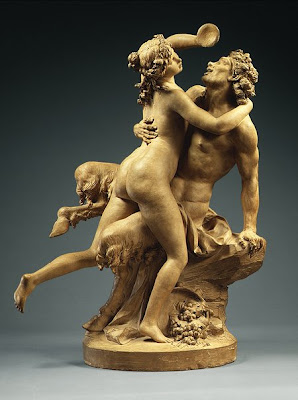 I have no inclination to talk academically on essay’s of note on “Art” but sometimes I get the urge to comment on selected “bits”! No highbrow stuff from me I’m afraid!
I have no inclination to talk academically on essay’s of note on “Art” but sometimes I get the urge to comment on selected “bits”! No highbrow stuff from me I’m afraid!
Cindy Jackson, on page seven of her essay entitled “Linear Form vs Organic Form” asks us to compare Rodin’s figures with Clodion. She concludes, I think, that there is no emotional content in Clodion’s anatomical master pieces where in Rodin’s it is all about emotion.
Art is, for me, all about emotion; so does this mean that Clodion’s work is not Art?

My wife felt she had had enough after room eight at the Royal Academy’s Rodin Exhibition last year. Not too much emotion but too many bodies!
Here in lies the difference?
I did not enjoy Rodin’s work as much as I thought I would. I was far too concerned that his feet and ankles were too big and thick respectively. It annoyed me in some cases, that he had left the mould joints and then there was so much dirty plaster. I really do hate the “Burgers of Calais”, as for Balzac he is “gross”. I think that is probably the emotion we are all talking about is it not? I find the Burgers stiff and lifeless, too short in the leg to be convincing; all in all rather depressing. Great stuff just what Rodin wanted me to feel? (Some bright spark pointed out the merit in the space between the figures. I think I agree with him!)
I would never however suggest these masterpieces should be forgotten, quite the contrary.
Now I do like the “Gates of Hell”, though I was disappointed at the “uncrispness” of the casting, for me it was far too bland. He must be credited for originality with “The Thinker” and “The Kiss”. The former is a great work with impressive “presence”, blockish and powerful; the latter unconvincing and with little passion!
Clodion however has a completely different appeal! Beautiful young women comfortable and unashamed in their bodies frolic in the risqué fashion of a more decadent era. He can escape in to naughtiness with the use of mythical Males”. True to his time Clondion is all about aesthetic beauty. One might compare Clodion with Mozart and Rodin with Tchaikovsky or Stravinsky.
We must never forget that artists have to eat and feed their families so occasionally they have to produce work that does sell in the contemporary market! Being true to your art can be very difficult if your offspring are about to become homeless and starving.
That said, let’s get back to “Linear Form vs Organic Form”
 But before I do, these two works have much more passion I think, Tegner above, Rodin below:
But before I do, these two works have much more passion I think, Tegner above, Rodin below:
http://www.scribd.com/doc/2075716/Linear-Form-vs-Organic-Form

.jpg)

First — I would like to distinguish two kinds of emotion.
one: there is the emotion expressed by whatever fictional character is being represented by sculpture. (despair, fear, lust, courage — whatever)
two: there is the emotion that the viewer feels when looking at the piece.
Second — I would like to assert that Cindy Jackson priveleges the first over the second — in both her own sculpture — and in her essay.
Another way of putting it – is that her interest in figurative sculpture is literary — which is the primary (and in my opinion) dreadful characteristic of Victorian and neo-Victorian sculpture.
Clodion and Rodin are very different — in feeling and especially in scale (I don’t think Clodion ever went bigger than the small table top)
But they are similar where it counts: their pieces are a joy to behold — because — as Cindy suggested somewhere in her essay — they are sensitive to how their forms are relating to the spaces around them. Though, even here, they are very different – because Rodin puts so much energy into the surfaces of his work – it sucks it out of the surrounding space. Rodin’s figures are selfish — they don’t get along with each other — even when — as in the Burghers – they are supposed to.
(at least –for me they’re both a joy — I’ve lived with this
and this one)for many decades.
Regarding the comments made about architecture — I’m afraid that I agree — the best architecture is sculpture — and vice-versa –and the ultimate expression of both is the sacred space of a cathedral or temple.
OK ?
Now do you have enough to argue with? 😉
Robert,
The new site looks good! Confetti!
I haven’t been visiting blogs because I am just drowning in work and life–first child finishing up his senior year, much traveling to colleges, etc. I apologize to you and Chris and all my e-friends…
I look at this and the response from Chris and see two characters at play. You are both wonderfully opinionated. And I’ll be interested to see what you think about the distinction between two types of feeling–something that seems quite right to me.
Mozart is an excellent comparison with Clodion; or, perhaps, Johann Sebastian’s last son, Christian, offers a closer parallel, as his music has the joy & innocence that Mozart delighted in, but which he felt ultimately felt obliged to rise above in trying to accommodate the pathetic into a complete view of life. To be honest, I find Clodion’s vision of sensual bliss more convincing than Rodin’s. Clodion attains it easily, with seeming simplicity, but a simplicity which no Romantic could ever recapture; that happy vision of life in the Age of Reason seems unattainable to the Romantics except through violent effort. The easygoingness and felicity of Clodion (and Mozart, J.C.Bach, and Fragonard) vanished with the French Revolution, and the only way back to the Romantics seemed ecstasy and death. And to the moderns: more ecstasy and more death.
I’m not making value judgements on the works as sculpture, just contrasting attitudes. And enjoying your subtle commentary and some bloody marvellous images.
Iian, welcome.
Joining the digital age in ‘sound’ soon, I plan to convert all my old LPs to work on a new digital system as ‘Hi Fi’ is a now a lot cheaper since the credit crunch.
In my studio, which is often rather lonely despite an elderly dog in attendance, I will be able to listen again to JC Bach and hope the renewed inspiration will ‘raise the roof’ of my creating.
Chris, your comments have kept me thinking long and hard but a suitable reply has not yet been committed to the key board; it will in due course no doubt. I am glad that Iian likes the connection between Clodion and his Musical contemporaries. This gives me something to hang my coat on if you follow?
The version of Psyche and Eros in the V & A would need a strong big table being 59 cm high (two feet) which is certainly smaller scale than much of Rodin’s work but not what one would at first think of as ‘small table top’. That aside I will continue to address the keys on this topic.
I have not reread Cindy’s essay but concentrated here on your comment Chris.
Emotion illustrated; emotion engendered, I understand.
One point that I want to clear up in my own mind is your use of literary.
There are for me two ways I can interpret that word.
One – illustrating a person or subject from a written source such as a story or historical figure.
And Two – a ‘style’ of artistic expression.
The first I understand the second I do not.
For example let us take Eve here. (I have a beautiful picture of Eve which I have mislaid but when I find it I will add it to my 100 top). She is in a very strange and rather awkward stance, in fact not a very natural position and not dissimilar to your Adam here. If I was to be asked what emotion they were feeling, I would go for the feeling ones gets when in disgraced but only in retrospect because I know the story having read the Bible. If I hadn’t then may be I would have said that Eve was cold (as in ‘La Frileuse’) and that Adam was about to throw the discus or perhaps on the run up to bowl (as in Cricket).
Now this may be heresy, or frivolity, or mockery, or you may consider me a Sassenach or just plain dumb, but when I actually look at the surfaces of Rodins’ work and try and understand the relationship with the surrounding space I become even more at a loss, the fog descends around me.
When I look at Rodin I see a departure from his immediate predecessors and contemporaries. What he lacks in anatomical accuracy he gains in expressive vitality and freshness. He employs the viewer’s natural ability to ‘fill in’ and makes it ‘work’ without loosing credibility. For me some of his poses are too ‘natural’ to capture real emotion (The Kiss) and others are just awkward and uncomfortable. But he is clever; I love this but this is even better and this is quite brilliant.
Nevertheless, I accept that Rodin was an important creator of fine sculpture and deserves his place in the history books and museums, I could even live with one or two of his works (this one for instance) but I do not get a feeling of much joy from him in fact quite the opposite. ‘The Gates Of Hell’ is just too successful! He was a great deal better at the female form that Michelangelo!
It is joy that I get from Clodion. The terra cotta texture of his ‘flesh’, the tickling of the ‘male gaze’ (as Amanda puts it) in his subject matter, the complexity of his decoration in the fashion of his time and the amazing success technically of an often very complex group adds up to fantastic works of real Art. But I wonder if his work is profound? Does it need to be?